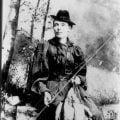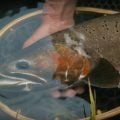How to Tie the Dynamite Balanced Leech
Producer: tightlinevideo
I call this fly the Dynamite Balanced Leech. It incorporates both a relatively new material as well as a recent arrival to the hook market. It also happens to be rather easy to tie and tremendously effective on the rivers and streams here in New Jersey. I can’t wait to give it a try on some still water.
The fly starts with a new hook to the Fulling Mill line-up, a 5125 short-shanked jig hook with a somewhat unique 45 degree eye. Begin by getting the hook firmly secured in the jaws of your tying vise.
For thread, I’ve loaded a bobbin with a spool of red UTC 70 Denier. Get the thread started on the hook shank behind the eye bend and, after taking a few wraps rearward, snip off the excess tag.
Although you can use a sequin pin to help balance the fly, I’m rather fond of 60 pound test Berkley Big Game, a 10 inch length will make numerous flies. Get hold of one end of the line and melt it into a nice little mushroom or sphere shape.
A 7/64” black nickel tungsten bead along with the monofilament is used to balance the fly. Insert the non-melted end of the monofilament into the countersunk or backside of one of the beads, then slip the bead down to the other end so the melted end seats in the recess of the bead. Pick up a small drop of superglue and apply it to the line between the bead and the melted end, then push the bead down to seat it on the melted end. Give a little tug to make sure the bead won’t pull off and is firmly secured on the mono. Snip the line off, leaving about 1/4” behind the bead.
Place the line on top of the hook shank so the back edge of the bead is a full bead-length in front of the front edge of the hook eye. Begin taking wraps of tying thread to bind the mono to the top of the hook shank, then continue taking thread wraps back to the start of the hook bend.
The tail of the fly is made up of a single strand of wormy material from a relatively new company called TyeSticks. The color I’m using here is called Scarlet into Fire. Think Barton Hall, May ’77. A small strand of monofilament embedded in one end of the material is what makes it unique and led to the inclusion of the word “dynamite” in this pattern.
Lay the small length of monofilament on top of the hook shank and take nice tight thread wraps to secure it. You want the wormy material to start right at the beginning of the hook bend. Once the material is secured, snip the excess core off close, then advance your tying thread to immediately in front of the hook point. A drop of super glue, here, Fly Tyer’s Z-Ment, applied to the thread wraps and allowed to sink in, will greatly increase the durability of the fly. Take additional thread wraps over top and through the adhesive to help set it, ending once again with your thread in front of the hook point.
The body of the fly is created using a rather ample clump of red Aussie Possum dubbing. Use the dubbing to build up a fairly substantial dubbing noodle on your tying thread that’s about 3” in length. This may or may not be enough, but it’s generally easier to deal with than a really long dubbing noodle.
Start taking wraps with the noodle so the dubbing begins right at the base of the tail. Wrap so the dubbing creates a body that’s roughly the same diameter as the tail. When you reach the bend in the shank, go around it, leaving the eye of the hook well exposed. If you’re a little shy of dubbing as I am here, go back to the packet and create a smaller noodle to fill in and clean up any space behind the bead, so the body of the fly looks something like this.
Reach for your whip finish tool and use it to do a 4 or 5 turn whip finish, seat the knot well and snip or cut your tying thread free. A drop of head cement applied to the thread wraps behind the bead will ensure they don’t come unraveled.
Once it sinks in and dries, the Dynamite Balanced Leech is almost ready to fish but there’s one last important step. Get hold of your dubbing brush, or here, just a little strip of Velcro, and rough out the Aussie Possum dubbed body. If there are any wonky bits sticking out, snip them off. But you do want the fly to look somewhat scraggly, about like this.
Don’t be dismayed if in the air the fly doesn’t balance as you see here. The only way to really test for balance is underwater where the fly will actually be used. Because the fly is relatively balanced, meaning it has a near horizontal orientation, it also has a ton of enticing movement which nearly any fish species will find hard to resist.
How to Tie the Duncan Loop Knot
How to Tie the Early Black Stonefly Nymph











